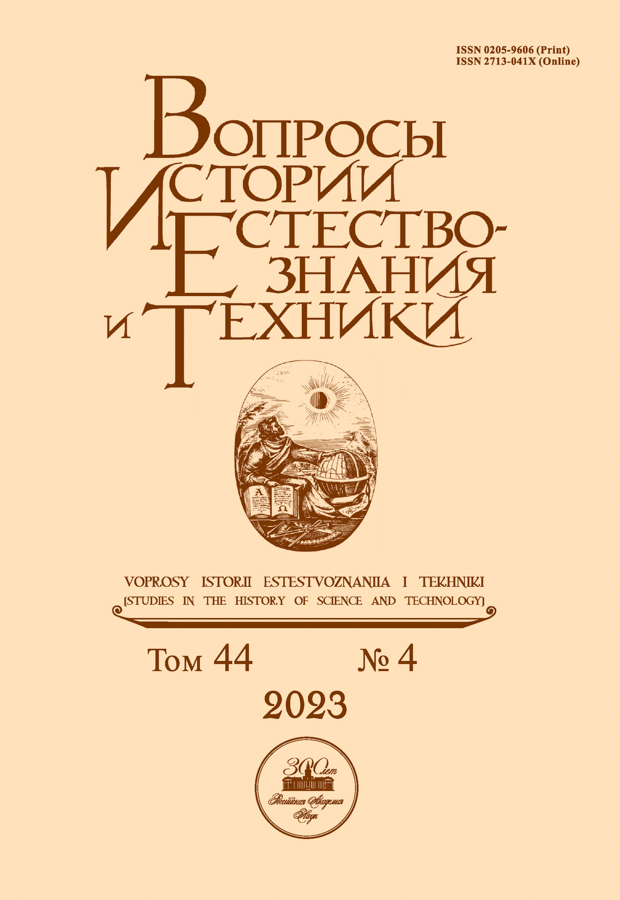卷 44, 编号 4 (2023)
From the History of Science
In Search of an Anti-Ageing Drug or the History of Gravidan Therapy in the USSR
摘要
 635-662
635-662


Social History of Science
Formation of Soviet-French Scientific Cooperation in the Field of Molecular Biology and Biochemistry in the 1960s (Based on the Materials of the V. A. Engelhardt Institute of Molecular Biology of the Russian Academy of Sciences)
摘要
 663-681
663-681


Lessons from History
Development of Chemical Industry in Russia (USSR) in the Context of Its Economic and Social Policies (1900–1927)
摘要
 682-706
682-706


Historical Reviews
The Description of Forest Fires in the Works of the Scientists Who Travelled the Russian Empire in the 18th – 19th Centuries
摘要
 707-723
707-723


Sources for the History of Science and Technology
Correspondence between Professor J. Heyrovský and Academician A. P. Vinogradov: Historical Aspect
摘要
 724-736
724-736


Institutions and Museums
“The Nest of the Famous Naturalist”: Early History of D. I. Mendeleev Museum and Archive
摘要
 737-774
737-774


Toward the History of the Origins and Development of French Horticulture Societies (19th – First Half of the 20th Century
摘要
This article focuses on the institutionalization of horticulture in France through the formation, self-organization, and development of horticulture societies. The author examines the origins of the French National Society of Horticulture (SNHF), the Horticultural Society of Lyon, and other regional organizations. Their common features include regular exhibitions, the publication of journals, and the development of scientific committees. The article also analyzes the difficulties encountered by the societies as well as their importance not only for plant breeding but also for France in general. The first such association, the Paris Society of Horticulture, was established in France in 1827. It subsequently changed its status and name many times and became the central and national organization. This did not mean, however, that many other associations could not be established in the regions and small cities. Despite numerous political crises in France in the 19th century, the societies continued their fruitful work. This process reached its peak in the early 20th century and only World War I with its devastating impact on French economy, science, and agriculture disrupted the development of plant breeding in the country. Not all of the horticulture associations survived this difficult period; some ceased to exist altogether while many others merged to form the new, much larger organizations. During the interbellum period, the societies’ periodicals were published regularly, they held met regular meetings, the exhibitions were organized, scientific work was carried out, and French horticulture became internationally recognized. Not having fully recovered after World War I, scientific research in France was disrupted by World War II. The consequences can still be seen today: France has not reached the amount and diversity of horticulture societies, journals, and exhibitions, or the number of researchers involved in these studies it had in the early 20th century.
 775-797
775-797


Essay Review
Why Did “Child Science” Never Become a Science? A New Book on the History of Pedology in Russia and the USSR
 798-805
798-805


Book Reviews
Feklova, T. Yu. Magnetic and Meteorological Observatory of the Academy of Sciences in Beijing: Chronicles of Event (Moscow, St. Petersburg, 2021), ISBN 978-5-4469-1893-5
 806-809
806-809


Fando, R. A., Sozinov, I. V. In Search of an Anti-Ageing Drug: Soviet MedicoBiological Projects of the 1920s – 1950s (Moscow, 2022), ISBN 978-5- 8037-0886-5
 810-816
810-816


Books in Brief
 817-820
817-820


Academic Life
Round Table in Memory of Bruno Latour
 821-827
821-827


Exhibition “Boris Mikhailovich Zavadovskii and His Museum”
 828-833
828-833


Events in Brief
 834-836
834-836


In Memoriam
Svetlana Sergeyevna Petrova (13.III.1933 – 10.VIII.2022)
 837-841
837-841














